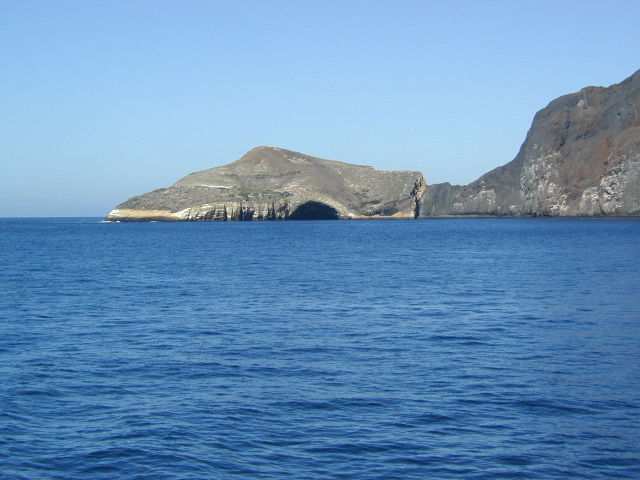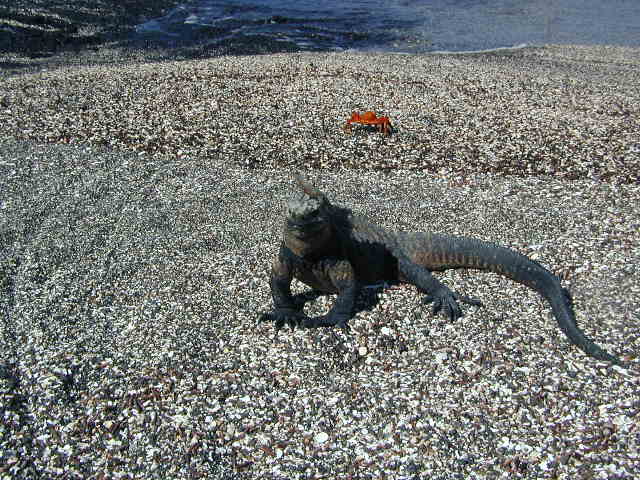
We crossed the equator for the first of six times overnight. The morning of New Year's Day saw us circle an outcropping called Roca Redonda, which rises in steep cliffs out of the water. Herman Melville claimed to have climbed it while on a whaling ship, but he claimed a lot of other implausible things. There were a lot of seabirds, particularly swallow-tailed gulls and Audubon's shearwaters, as well as some storm petrels, frigatebirds and red-billed tropic birds.
Just before 10 a.m. we crossed back to the southern hemisphere and had the "crossing the line" ceremony. I was exempt, as I'd crossed the equator at sea before. The basic elements of the ceremony were the same but it was, overall, tamer than my past experience. Nobody was smeared with anything particularly disgusting, for example. They just made people kiss a large frozen fish, drink fruit juice that they called "iguana blood", and be squirted with cold water from a hose.
We sailed down a ways to Punta Vicente Roca on Isabela Island, where we took a panga ride. One highlight was cruising into a beautiful lava cave.

We saw the usual sea lions, marine iguanas, blue-footed boobies and some Nazca boobies. One pelican landed in the water right next to us. We later heard that one had actually landed in a panga and perched on someone's arm!

But the real highlight was seeing some penguins! The Galapagos penguin is the northernmost one in the world and the third smallest. They're also a leading competitor in the endemic animal cuteness competition. It's particularly dramatic how their awkwardness on land is transformed into speed and agility in the water. Other sightings included sea turtles, noddy terns, flightless cormorants and fur seals. And a feral cat. Even though I like cats, the feral ones in the Galapagos are not a good thing, since they're quite destructive to the bird population.
Back on board, the ship was sailing on to Fernandina (the westernmost island of the archipelago) when there was an announcment of a dolphin sighting. We quickly finished our lunch and went out on deck. I was amazed and thrilled as hundreds of common dolphins rode our bow wake. They splashed and jumped all over, putting on an incredible water ballet for us.
In the late afternoon, we had a dry landing on Fernandina, which featured a fairly easy hike over ropy pahoehoe lava. It was interesting to see cacti growing right out of the lava.

As for wildlife, there were a few American oystercatchters, a flightless cormorant and some sea lions. But the main thing to see were a lot of marine iguanas. These were less colorful than the ones on Espanola had been, but were still interesting. I was amused by one who had a lava lizard on his head.

The tide was too high to walk part of the trail so we waded another small area and got in a panga to go out and look for penguins. And, indeed we found some.

We also found a lot of other birds. There were the usual blue-footed boobies, for example, and the far less usual striated heron. The weirdest looking birds, though, are the flightless cormorants. They're well adapted for diving, but their short stubby wings are entirely out of proportion with their bodies.

Back on board, we sailed north again and were treated to a replay of the dolphin show. They were gorgeous to watch, leaping high into the air against the setting sun. The captain circled the ship through the pod so we could watch for a long time. It was quite a way to start the year.
Back to Previous Chapter | Back to Ecuador Index | On to Next Chapter | Xenophilia Home
last updated 19 January 2002